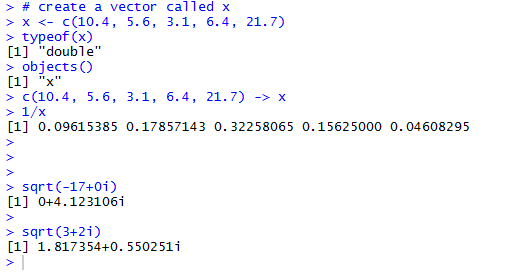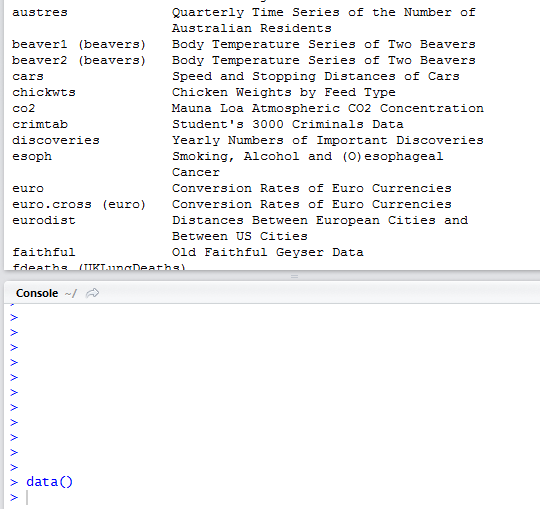Syntax, semantics
So what does R actually look like, what datatypes does it have, what operators? How are functions declared and called?
R particularly shines when it comes to operations on vectors (ordered LIST of elements), arrays, matrices and tables - all of which are built-in ('native') datatypes. Just like in Python (where list is the central data type), in R, it is all about vectors (R does have a list type as well). This is very similar to TensorFlow's use of a 'tensor' (which is a vector in R!).
R code can be executed interactively in a shell, or be run from a .R source file (script).
R is a functional programming language..
# create a vector called x
x <- c(10.4, 5.6, 3.1, 6.4, 21.7)
typeof(x) [and class(x) and mode(x)]
objects()
# alternative
assign("x", c(10.4, 5.6, 3.1, 6.4, 21.7))
c(10.4, 5.6, 3.1, 6.4, 21.7) -> x # !!!
1/x
y <- c(x,x) # y will have 10 entries
v <- 2*x + y + 1
# generates a new vector v of length 10 constructed by adding together,
# element by element, 2*x repeated 2 times, y repeated just once,
# and 1 repeated 10 times - in other words, this is a 'vector' op!
Here are sample operations (in RStudio):

Several functions operate on a vector, eg. range(), min(), max(), sum(), prod(), mean(), sort()..
Sequences are easy to create:
# c(1,2,3,4.....30) > m <- 1:30 > m [1] 1 2 3 4 5 6 7 8 9 10 11 12 13 14 15 16 17 18 19 [20] 20 21 22 23 24 25 26 27 28 29 30 > n <- seq(2,5) > n [1] 2 3 4 5 >
Logical vectors (comprised of T,F) are created via conditions, eg.
> temp <- x>13 > temp [1] FALSE FALSE FALSE FALSE TRUE >
Matrices/arrays are muti-dim versions of vectors [matrices can only be 2D, arrays can be any nD].
Lists can have elements of different types (vectors cannot).
Data frames are matrix-like structures, in which the columns can be of different types - this is how we can create/read in relations (table data!)! Eg. data.frame(x,y) will create a 2-column (x,y) table out of vectors x and y.
With a vector type, the following three things are possible, which makes it more powerful than a list:
- per-element operations are automatic, ie if x<-c(1,2,4), 1/x is (1,0.5,0.25)
- aggregate operations are possible, eg mean(x), and colMean(m) where m is a matrix
- vectors of different types (each vector is a column) can be aggregated into tables (ie. data frames)
Summary - R's (only) five non-atomic datatypes [first three are for identical (homogenous) elements, last two are for different (heterogenous) elements]:
- vector - a seq with identical types of elements
- matrix - a vector shaped as a rect (2D)
- array - a vector of >2D [because vector is for 1D, array is for 2D]
- list - a seq with different types of elements
- data frame [analogous to a (relational) table of data] - list of column vectors, columns can be of different types
This page mentions the differences between a vector, matrix, array, list and dataframe (mnemonic: "v-mald").
The following two diagrams [second is a screenshot from here] also illustrate the built-in datatypes (the first mentions 'factor' - this is simply a specific vector type, so it's not a new type).


Functions are objects as well (like with Python, JavaScript..). "The function tapply() is used to apply a function, here 'mean()', to each group of components of the first argument, here 'incomes', defined by the levels of the second component, here 'statef'" (sound a lot like Python's map()?):
> incmeans <- tapply(incomes, statef, mean)
Easy to write vector-oriented functions:
> stderr <- function(x) sqrt(var(x)/length(x))
Arrays can be created from vectors, via dim():
# if z has 1500 elements, here is how it can be turned
# into a 3D array:
> z = 1:1500
> dim(z) <- c(3,5,100)
> z
, , 1
[,1] [,2] [,3] [,4] [,5]
[1,] 1 4 7 10 13
[2,] 2 5 8 11 14
[3,] 3 6 9 12 15
, , 2
[,1] [,2] [,3] [,4] [,5]
[1,] 16 19 22 25 28
[2,] 17 20 23 26 29
[3,] 18 21 24 27 30
, , 3
[,1] [,2] [,3] [,4] [,5]
[1,] 31 34 37 40 43
[2,] 32 35 38 41 44
[3,] 33 36 39 42 45
....
....
data() lists sample datasets:

edit() is used to edit data, spreadsheet-fashion:
xnew <- edit(xold) xnew <- edit(data.frame())
R has a lot of probability distribution functions built-in:

A stem-and-leaf plot of data is easy to generate:
> attach(faithful) # READ in a dataset > summary(eruptions) Min. 1st Qu. Median Mean 3rd Qu. Max. 1.600 2.163 4.000 3.488 4.454 5.100 > fivenum(eruptions) [1] 1.6000 2.1585 4.0000 4.4585 5.1000 > stem(eruptions) The decimal point is 1 digit(s) to the left of the | 16 | 070355555588 18 | 000022233333335577777777888822335777888 20 | 00002223378800035778 22 | 0002335578023578 24 | 00228 26 | 23 28 | 080 30 | 7 32 | 2337 34 | 250077 36 | 0000823577 38 | 2333335582225577 40 | 0000003357788888002233555577778 42 | 03335555778800233333555577778 44 | 02222335557780000000023333357778888 46 | 0000233357700000023578 48 | 00000022335800333 50 | 0370
There is more to learn! If you are interested, go through the books/sites listed at the end of this lecture. Meanwhile, here is a '.R' script filled with practice commands; this is another (neither of these are mine).
Here is a nice reference card that summarizes all the aspects of R.
